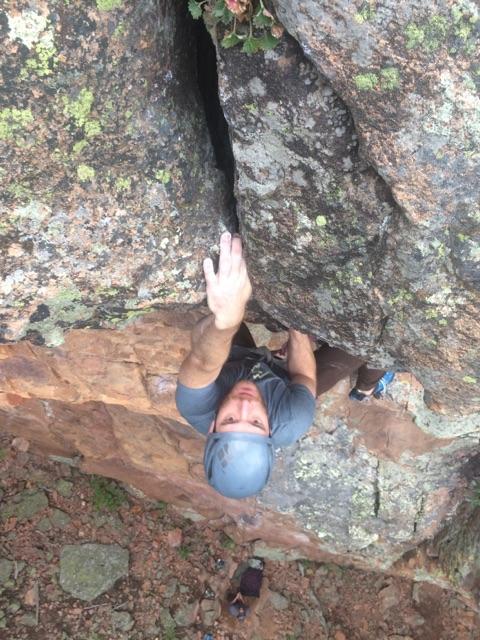Slab, Cracks, and all things Granite
The Quantum is pretty strong on granite, particularly when striking the balance between edging and smearing, and it quickly became one of my favorite slab shoes. The Quantum is built with a stiffer midsole, but has some play towards the front. In addition, its slightly-wider last through the toe box allows for flatter-footed contact with the rock when smearing.
This design also makes for decent edging performance, too: the stiffness in the Quantum’s midsole helps delay foot fatigue, but there’s still enough sensitivity on the inside edge to feel your way around.
The Quantum’s flex is phenomenal for those sloping protrusions that one often encounters on steep, granite faces, but it doesn’t keep pace with high-end sport shoes for walking up dime edges. This is ultimately the limitation of any “do-everything” shoe: aggressive sport climbing shoes with more downturn or asymmetry than the Quantum (like the SCARPA Instinct, Five Ten Dragon, Tenaya Iati, or La Sportiva Otaki) simply grant greater precision when working with tiny flat edges or pockets. Those are relatively specialized shoes, however, and the Quantum is shooting for a broader application.
In cracks, the Quantum is competent, but this depends greatly on your ability to fit the shoe comfortably enough to jam. If you can get a truly comfortable fit, you’ll be able to go straight in on most crack sizes without inordinate difficulty, but this hinges on how you are able to situate your toes. So depending on the volume and shape of your feet, you may have more or less success here.

The positive notes here are that Quantum’s laces sit flat and don’t get quickly chewed up if you climb cracks regularly, and the outside rubber is easy to work with for rand smears around thinner cracks.
I personally get the most out of the Quantums when I size them snug and use them for technical face climbing, or hard trad climbs in places like Eldorado Canyon, CO, where gear-protected pitches require a variety of face and crack techniques, but rarely sustained, straight-in jamming. By way of example, climbs like Foxtrot and Pony Express really cater to the strengths of the Quantum.
Weaknesses
The Quantum does, however, have a little bit of a blind spot for thin hands and off-finger sizes. Its slightly boxy toe creates the same problem for straight-in jamming on thinner cracks that the Sportiva TC Pro has, though maneuvering the Quantum requires a little more thought because of the moderate downturn.
Who’s It For?
While newer climbers are smart to look for an “all-around” shoe to learn in, true beginners will be just as well served by low-end, do-everything shoes as they are by high-end generalists like the Quantum. Conversely, climbers who are pushing into elite grades or zeroing in on a specific discipline will likely do better in a more specialized shoe. So the ideal audience for the Quantum is intermediate to advanced climbers looking for a single shoe to take to the gym and the crag.
To flesh that out a bit: for either super long days or sustained cracks, I would opt for something flatter and stiffer in the midsole that places a higher premium on comfort, so the Quantum wouldn’t be my first choice for The Nose or Indian Creek. On the other hand, for diverse climbing that incorporates face holds, stemming, short stretches of cracks, and general granite trickery, the Quantum fares pretty well. I took them out to Devil’s tower, The Black Wall on Mt Evans, and the Black Canyon of the Gunnison (in addition to my go-to local crags and the gym) and was pretty pleased with their performance.
Bottom Line
Overall, the new Five Ten Quantum works quite well as an all-arounder, though it’s probably best to think of it as a high-achieving, all-day granite shoe. Climbs that range from slab to vertical granite with lots of edging play to the strengths of the Quantum. For Indian Creek splitters where you are often going straight in on difficult cracks, I personally prefer a flatter last and lower-profile toe box than the Quantum offers, but bigger routes on granite walls are almost universally much more varied than the offerings in the desert, and the Quantum works very well for that more diverse style of climbing.
